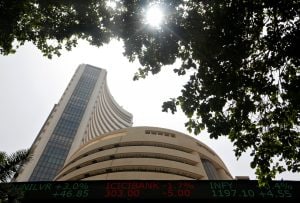Eye on Earnings: These 10 stocks may double their net profit on year-on-year basis in Q1 FY19

KV Prasad Jun 13, 2022, 06:35 AM IST (Published)
 Listen to the Article (6 Minutes)
Listen to the Article (6 Minutes)
Summary
Rupee depreciation versus the dollar, higher current account deficit and rising crude prices remain a concern.
India Inc will start unveiling results for the quarter-ended June starting this week, beginning with bellwether IT names like Tata Consultancy Services and Infosys. Most brokerages expect a double-digit earnings growth for Nifty companies in first quarter of financial year 2019.
Rupee depreciation versus the dollar, higher current account deficit and rising crude prices remain a concern. Experts see some recovery in the banking sector as much of the asset quality pain is already recorded and insolvency resolutions are underway.
Revival in rural demand on the back of a normal monsoon, higher minimum support price and positive sentiment is benefitting the domestic consumption theme. With significant stress recognition already undertaken by banks, asset quality would be relatively better in first quarter FY19e.
“The economy has witnessed a significant improvement in the demand environment over the last 4 quarters, which is evident from the revenue growth of Sensex companies that are up 10% year-on-year compared to average growth of 2% year-on-year over the past 12 quarters,” ICICIDirect said in a note.
“We expect revenue growth to further accelerate to 15% year-on-year in first quarter FY19e given the broad-based pick-up across sectors, except telecom. Going forward, with much of the asset quality pain already recorded, IBC resolutions underway in the banking space, firm rural demand and pick-up in industrial activity, we expect earnings to stage an impressive recovery, growing in excess of 20% CAGR over FY18-20e,” it stated.
The first six months of 2018 was like a roller coaster ride for Indian markets. The next six months are unlikely to be any different, but one thing which provides comfort is earnings growth that could hit the double-digit market in the next 2 fiscals.
Risk for the market remains more on the downside than on the upside, Mahesh Nandurkar, India Strategist, CLSA, said in an interview to CNBC-TV18. Even though the earnings multiple remains high for the Indian market, the brokerage is confident of a strong economic recovery in the next 2 fiscals.
“We are building a reasonable 20% earnings growth in fiscal year 2019 and fiscal year 2020 with a bottom-up perspective. The earnings downgrade trend has not ended as yet, as even in the March quarter results we saw some downgrades. In fiscal year 2019, there is still a risk to the downside in certain sectors,” he stated.
Here is a list of top 10 stocks from different brokerages that may more than doubled their net profit on a year-on-year basis in the June quarter:
From Kotak Institutional Equities
Apollo Tyres: PAT likely to grow 173 percent year-on-year
Kotak Institutional Equities expects Apollo Tyres’ first quarter net profit to grow 173% year-on-year to Rs 241.80 crore. Net sales are likely to rise 21% year-on-year to Rs 3,988.90 crore.
Standalone revenues are expected to increase 20% year-on-year due to:
- 19% percent year-on-year increase in tonnage volumes on the back of a strong pick-up in the medium and heavy commercial vehicle segment (partly due to lower base) and continued strong growth in the passenger vehicle segment.
- Slight increase in average selling price.
The brokerage expect earnings before interest, tax, depreciation and amortisation (EBITDA) margin to remain flattish on a sequential basis (up 590 basis points year-on-year) as price increases will offset raw material cost pressures. Europe revenues are likely to grow 23% year-on-year, led by double-digit volume growth and benefit of the euro appreciation versus the rupee.
Ashok Leyland: PAT likely to grow 234% year-on-year
It expects net profit of Ashok Leyland to grow 234% year-on-year to Rs 372.30 crore in first quarter.
Kotak Institutional Equities sees revenues increasing 51% year-on-year led by:
- 48% year-on-year growth in volumes.
- Price increases undertaken by the company. EBITDA is likely to grow 111% year-on-year as it expects EBITDA margin to improve 290 bps due to operating leverage benefits. This despite a 160 bps year-on-year decline in gross margin due to increase in commodity costs.
MRF: PAT may grow 258% year-on-year
The brokerage expects MRF’s net profit to grow 258% year-on-year to touch Rs 382.30 crore for the quarter ended June. It expects revenues to grow 15% led by strong double-digit volume growth across segments and 1-2% higher realisations on account of price increases undertaken by the company. Kotak Institutional Equities has found a strong pick-up in two-wheeler replacement segment volumes. EBITDA margin is likely to remain largely flattish on a sequential basis (up 1,020 bps year-on-year) as RM cost pressures will be offset by price increases.
Jubilant FoodWorks: PAT likely to grow 168% year-on-year
Kotak Institutional Equities expects net profit of Jubilant FoodWorks to grow 168% year-on-year to Rs 64 crore. EBITDA margin is likely to expand 400 bps year-on-year despite a 245 bps contraction in gross margin, aided by leverage, cost-saving initiatives and Goods & Service Tax-related opportunities.
United Spirits: PAT may grow 284% year-on-year
It expects net profit of United Spirits to grow 284% year-on-year to Rs 242.10 crore for first quarter. “We model a 14% net revenue growth led by 9.3% growth in underlying volumes off a low base. On a reported basis, we expect lower volume growth of 8.2% percent year-on-year on account of low-end franchising impact.” The domestic brokerage firm modelled 245 bps year-on-year expansion in gross margin on account of RM softness. At an EBITDA level, it expects expansion to be higher at 450 bps year-on-year driven by leverage benefits and cost-rationalisation measures.
From ICICIdirect.com
Jyothy Laboratories: PAT is likely to grow 141.6% year-on-year
The net profit of Jyothy Laboratories is expected to grow 141.60% year-on-year to Rs 49.80 crore. ICICIdirect.com is likely to post a 26.3% year-on-year sales growth backed by strong growth in the dishwashing and fabric care segments. GST-related trade channel disruption witnessed in first half of financial year 2018 normalised in third quarter, driving volume growth in fourth quarter and is expected to drive volumes in first quarter of financial year 2019 also (first quarter of financial year 2018 saw steep volume de-growth of 17% year-on-year). The brokerage expects margin to surge 550 bps on robust topline numbers.
Prabhat Dairy: PAT likely to grow 111.8% year-on-year
ICICIdirect.com expects net profit of Prabhat Dairy to grow 111.8% year-on-year to Rs 12.40 crore. Higher volume on the back of increasing capacity utilisation of the cheese facility would drive sales growth of 13.6% to Rs 408.4 crore. Milk procurement prices have fallen 10% year-on-year to Rs 22. “We expect operating margins to improve 52 bps year-on-year to 8.4%. Net profit is expected to grow to Rs 12.4 crore.”
Cadila Healthcare: PAT may grow 240.3% year-on-year
Cadila Healthcare is likely to deliver a 240.30% year-on-year growth to Rs 471 crore. Revenues are expected to grow 45% to Rs 3,229 crore due to continued windfall of gLialda and strong growth in domestic formulations (albeit on a lower base). EBITDA margins are likely to improve 925 bps year-on-year to 21.2% on better product mix, lower research spends and base effect (GST impact). Net profit is expected to increase 240% year-on-year to Rs 471 crore on strong operational performance.
Dr Reddy’s Laboratories: PAT likely to grow 365% year-on-year
It expects Dr Reddy’s Laboratories’ net profit to grow 365.70% year-on-year to Rs 310.20 crore. Revenues are likely to increase 7% to Rs 3,577 crore due to 30% growth in India. But the same is likely to be partially offset by muted growth in the US. EBITDA margins are expected to improve 756 bps year-on-year to 17% on better product mix and lower base (GST impact). Net profit is expected to increase to Rs 310 crore against Rs 67 crore in first quarter of financial year 2018 due to strong operational performance and lower tax rate (23% versus 29.4% in first quarter of financial year 2018).
Natco Pharma: PAT may grow 164.40% year-on-year
ICICIdirect.com expects Natco Pharma net profit to grow 164.40% year-on-year to Rs 248.50 crore. Revenues are likely to grow 54% to Rs 660 crore due to complex products launches in the US (gCopaxone, gDoxil). EBITDA margin are likely to increase to 50% from 31.9% year-on-year on continued gCopaxone windfall.
Disclaimer: The views and investment tips expressed by investment experts are their own and not that of the website or its management. Users are advised to check with certified experts before taking any investment decisions.
Source: Moneycontrol.com

Elon Musk forms several ‘X Holdings’ companies to fund potential Twitter buyout
3 Mins Read
Thursday’s filing dispelled some doubts, though Musk still has work to do. He and his advisers will spend the coming days vetting potential investors for the equity portion of his offer, according to people familiar with the matter

KV Prasad Journo follow politics, process in Parliament and US Congress. Former Congressional APSA-Fulbright Fellow











 Listen to the Article
Listen to the Article  Daily Newsletter
Daily Newsletter













